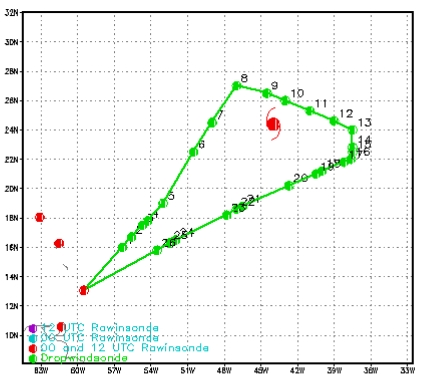
| Lead Scientist | Jason Dunion |
| Dropsonde Scientist | Sim Aberson |
| Visiting Scientist | Jeff Hawkins (NRL) |
| Aircraft Commander | Michele Finn |
| Pilots | John Longenecker Will Odell |
| Project Manager | Jack Parrish |
| Flight Meteorologist | Barry Damiano |
| Equipment Specialist | Gordon Kitson |
| Electronics Technician | Dale Carpenter
Chuck Rasco Jeff Smith |
Mission Plan :
NOAA 49RF will fly a Saharan Air Layer Experiment (SALEX) around Tropical Storm Debby as part of IFEX. The G-IV will leave Barbados at 1450 UTC and will recover back at Barbados at 2220 UTC. The flight track will take the G-IV on a clockwise circumnavigation of the TC and is shown in Fig. 1, along with the 26 dropwindsonde points.

Mission Summary :
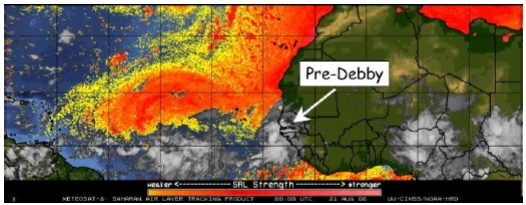
a) Synoptic Situation
Pre-Tropical Storm Debby emerged from the coast of North Africa as a well
organized AEW on 21 August (Fig. 2). Figure 2 also shows that a very large
Saharan Air Layer (SAL) outbreak was located to the north and west of this
system at this time. The NASA DC-8 flew a single mission into pre-Tropical
Storm Debby on 23 August from Sal, Cape Verde. This mission was part of the
NAMMA field program and the main objectives included cyclogenesis, Saharan Air
Layer/dust, and microphysics studies. The disturbance tracked to the northwest
[around the southwest periphery of a deep layer ridge, Fig. 3 (left)] over the
next several days, which brought it into the suppressive influence of SAL and
within range of the NOAA G-IV.
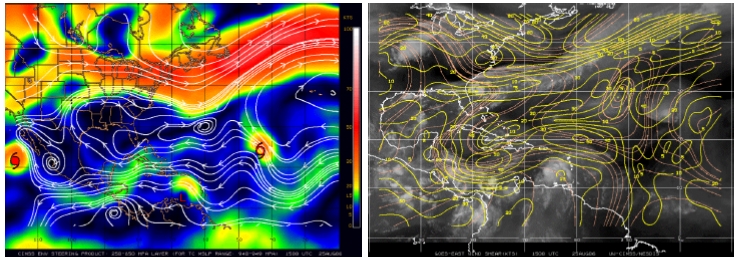
The G-IV was deployed to Barbados on 24 August for a back-to-back set of SALEX missions beginning on 25 August. At 1800 UTC during the day of the mission, Tropical Storm Debby was located at ~24.4 N 44.0 W. A large deep layer ridge was located to its northeast and an amplifying upper level cold low was located ~1000 km to its northwest. The center of the storm was under the influence of ~20 kt of southerly shear, while just northwest of the center, the shear was 30-40 kt from the south-southwest [Fig. 3 (right)]. This area of enhanced shear was likely being partly generated by the upper-level cold low to the northwest of Debby.
b) Mission Specifics
The flight plan was designed to investigate a large SAL outbreak that was
surrounding Tropical Storm Debby (Fig. 4, SAL 2) and the moist tropical
environment immediately surrounding the storm [Fig. 4 (TPW >45 mm)]. The flight
plan called for a clockwise
circumnavigation of the storm at an optimal flight level of 41,000-45,000 ft
and required that all dropwindsondes be transmitted in real-time, so that the
humidity data from the sondes could be included in parallel runs of the NOAA
GFS model. Takeoff was at 1450 UTC from Barbados and within ~45 min (Fig. 4,
drop #2), the G-IV was overflying the SAL (Fig. 4, SAL 2).

The 700 hPa relative humidity for drops 2-8 was ~10-30% and not until drop #9 did these middle levels of the atmosphere moisten-up significantly. The moisture gradient in the region between drop #8 and drop #9 was significant: the 700 hPa RH at drop #8 was ~15% and was ~60% at drop #9. GPS dropsondes launched during the easternmost north-south leg (drop #s 13-16) showed ~20-25% RH at 700 hPa and drop #20 southeast of the storm center showed dry mid-level air (~14% RH at 700 hPa) collocated with a 20 kt 700 hPa jet from the south. This suggested that dry SAL air was likely being advected toward the inner core region of the torm. Indeed, zoomed AMSR-E TPW imagery from a 1551 UTC Aqua overpass indicated that the SAL had advanced well north of drop #20 [Fig. 5 (right), TPW <45 mm (green shading)]. Saharan dust was also clearly visible during a large portion of the mission and was evident in Meteosat-8 visible imagery [Fig. 5 (left)]. The suspended Saharan dust is discernable as a milky white haze in this visible satellite image. Figure 6 shows the 060825n flight track overlaid on the 25 August 1800 UTC GFS analysis of 700 hPa relative humidity. It appears that the GFS was overestimating the mid-level moisture in regions of the SAL by a factor of 2-3 times. A combination of one UBLOX and one “older style” codeless GPS dropsondes were launched at drop points 14 and 16 to assess possible dry biases in the older style GPS dropsondes. Given the extreme dryness of the SAL environment, possible biases such as this are of extreme interest. These drop points were made along the easternmost north-south leg and were both clearly launched in the SAL environment (Fig. 5).
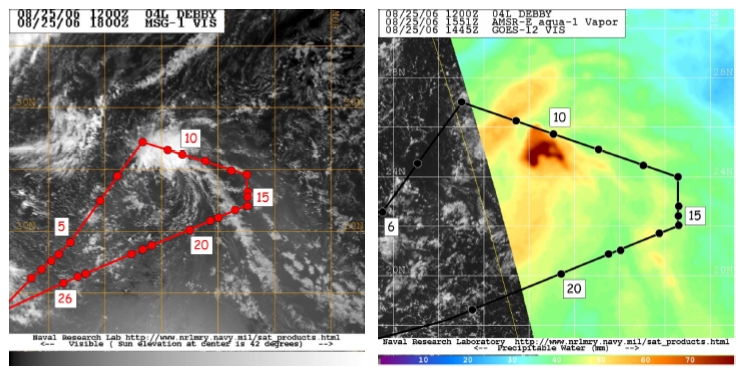
Problems :
There were no major problems related to this flight. Although 'codeless' GPS dropsondes mainly from 2000-2004 were used, only three sondes failed out of the 31 that were dropped.
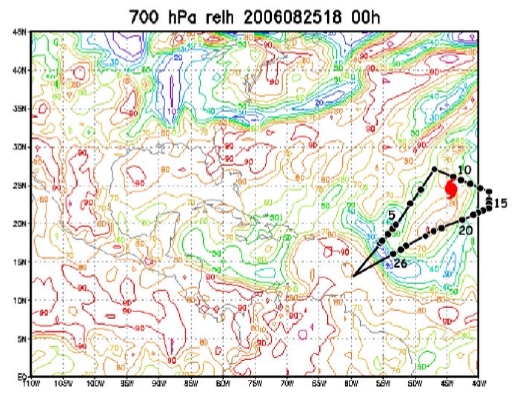
Flight Data :
Page last updated November 9, 2006
Return to Mission page.